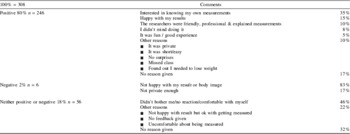With increasing overweight and obesity among adolescents in Ireland( 1 ), it is generally agreed that monitoring trends in body weight is important to effectively plan management and prevention strategies. We must also take account of what adolescents are telling us about body image and how it impacts their lives( Reference O'Connell and Martin 2 ). Our study wished to address the experience of an adolescent group having their weight, waist circumference and height taken as part of a research study.
Five Irish postprimary schools enrolled fourth year classes (aged 15–17 years) in the study. Weight, height and waist circumference were measured on the school grounds by trained health professionals including dietitians, nutritionists, nurses and doctors. Screens provided privacy for participants while measurements were being taken. At the end of the study period, all students were asked to complete an anonymous participant-evaluation questionnaire.
Seventy-two percent (362/500) participated in the anthropometric measurements. Response rates were higher in single gender schools and ranged from 58% (120/206) in a mixed gender school to 86% (67/78) and 91% (41/45) in a female only and male only school respectively. Principal reasons given for not participating were lack of interest in the study, absenteeism, and feeling uncomfortable about being measured. Eighty-five percent of students (308/362) who took part in anthropometry completed an evaluation survey. Students were asked to rate the experience as ‘positive’, ‘negative’ or ‘neither positive or negative’ and comment on their response.

Recruitment for anthropometric research in the school setting may be lower in mixed gender postprimary schools. Overall, the experience of having anthropometric measurements taken was a positive one for adolescents. Given the importance of monitoring overweight and obesity prevalence among younger population groups, it is worth being attentive to their experience as participants. Good communication, putting participants at ease and providing feedback are highlighted in these results.


